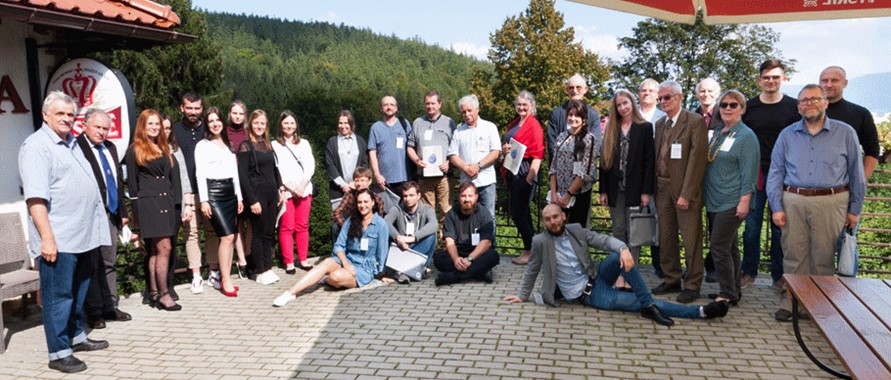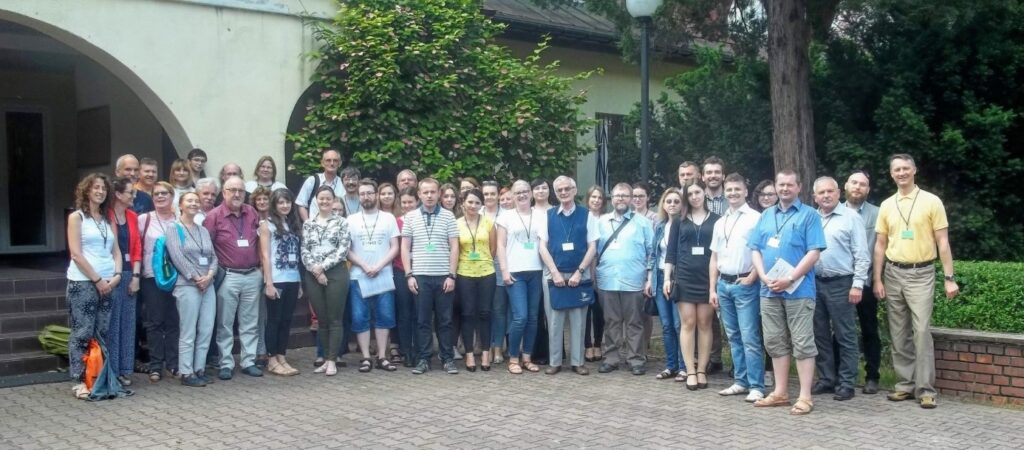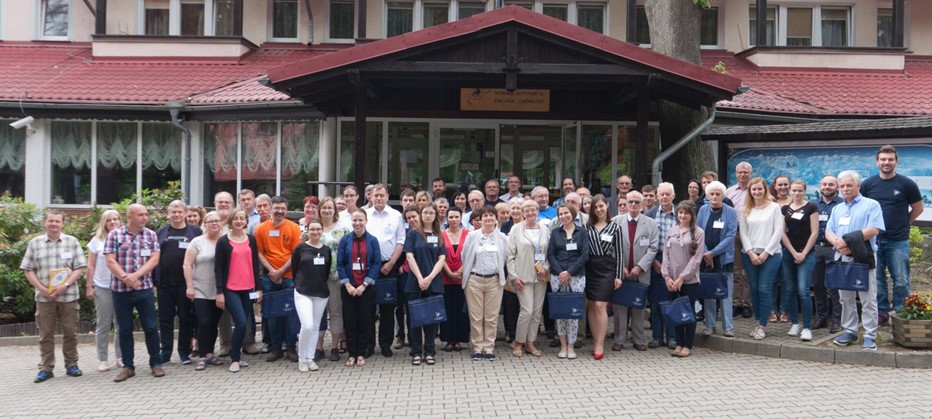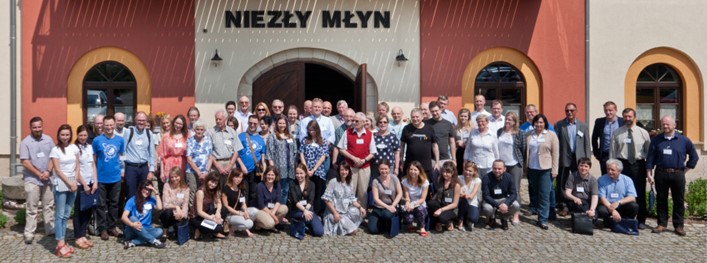THE HISTORY OF EMPOC
The meetings called European Meeting on Physical Organic Chemistry (EMOPOC) are organized by the Section of Physical Chemistry of Organic Compounds operating in the frame of the Polish Chemical Society. The Section’s activities aim to establish and maintain scientific contacts between researchers dealing with physical and theoretical chemistry, physicists and biologists. Members of the Section meet at annual schools/conferences organized since 1974. The meetings allow us to learn about the state of knowledge about the main, selected in advance topics, it is also an occasion to present the achievements of participants and to exchange scientific ideas. Since 2003, the Schools have been international meetings called the Central European School on Physical Organic Chemistry, in 2018 they changed their name to the European Meeting on Physical Organic Chemistry (EMPOC).

Conferences organized or co-organized by the Section of Organic Physicochemistry:
- Towards understanding the nature of noncovalent interactions (XLII European Meeting on Physical Organic Chemistry), Karpacz, 5-9 June 2023
- Chemistry in a Confined Space (XLI European Meeting on Physical Organic Chemistry), Karpacz, 13.09-17 June 2022
- Structure and Reactivity, (XL European Meeting on Physical Organic Chemistry) Spała, 03-07 June, 2019
- From Calculations to Experiment in Chemistry and Biology, (XXXIX Central European School on Physical Organic Chemistry) Karpacz, 04-08 of June, 2018
- Molecular Interactions in Chemistry and Biology, (XXXVIII Central European School on Physical Organic Chemistry) Czeszów, 29.05-02.06.2017
- Movement in Chemistry, (XXXVII Central European School on Physical Organic Chemistry) Przesieka, 06-10 of June, 2016
- XXI International Conference on “Horizons in Hydrogen Bond Research”. (XXXVI Central European School on Physical Organic Chemistry) Wrocław, 13-18 of September 2015
- Modeling, Molecules, Processes and Properties, (XXXV Central European School on Physical Organic Chemistry) Przesieka, 26-30 of May 2014
- From Molecule to Material. Chemistry for the Future, (XXXIV Central European School on Physical Organic Chemistry) Przesieka, 27-31 of May, 2013
- Self-Organisation and Interactions Behind, (XXXIII Central European School on Physical Organic Chemistry) Przesieka, 7-11 of May 2012
- The Lewis and Brönsted acid-base and related interactions, (XXXII Central European School on Physical Organic Chemistry) Przesieka, 6-10 of June 2009
- Intermolecular Interactions and Molecular Recognition, (XXXI Central European School on Physical Organic Chemistry) Przesieka, 8-12 of June 2010
- Weak molecular interactions, (XXX Central European School on Physical Organic Chemistry) Przesieka, 2-6 of June 2009
- Structure and Properties of Organic Chemistry, (XXIX Central European School on Physical Organic Chemistry) Karpacz, 8-12 of June 2008
- Energetics in Chemistry (XXVIII Central European School on Physical Organic Chemistry) Karpacz, 4-9 of June 2007
- Structural Organic Chemistry (XXVII Central European School on Physical Organic Chemistry) Czocha, 19-24 of June 2005
- Nowe materiały Molekularne (XXVI Szkoła Fizykochemii Organicznej) Polanica Zdrój 7-11 of June 2004
- Metody Fizykochemiczne Badania Oddziaływań Międzycząsteczkowych w Układach Biologicznych (XXV Szkoła Fizykochemii Organicznej) Przesieka, 9-14 of June 2003
- Nowe metody w spektroskopii molekularnej, (XXIV Szkoła Fizykochemii Organicznej) Karpacz, 10-15 of June 2002
- Russian-Ukraine-Polish Conference on Molecular Interactions, (XXIII Szkoła Fizykochemii Organicznej) Gdańsk, 10-16 of June 2001
- Wpływ Otoczenia na Właściwości i Reaktywność Związków Organicznych (XXII Szkoła Fizykochemii Organicznej) Przesieka, 12-17 of June 2000
- XIIIth Conference – Workshop. Horisons in Hydrogen Bond Research Świeradów Zdrój, 2-9 of September 1999
- Acid-Base Properties of Organic Compounds (XXI Szkoła Fizykochemii Organicznej) Przesieka, 1-6 of June 1998
- Molecular Modeling (XX Szkoła Fizykochemii Organicznej) Kudowa Zdrój, 2-7 of June 1997
- Zjawiska relaksacyjne (XIX Szkoła Fizykochemii Organicznej) Przesieka, 9-14 of September 1996
- Shaping of Vibrational Spectra and Molecular Interactions (XVIII Szkoła Fizykochemii Organicznej) Przesieka, 6-11 of June 1995
- Teoretyczne i eksperymentalne aspekty struktury cząsteczek (XVII Szkoła Fizykochemii Organicznej) Karpacz, 5-10 of June 1994
- Summer School on Isotopic Effects (XVI Szkoła Fizykochemii Organicznej) Karpacz, 20-25 of June 1993
- Seminarium – komputery w chemii Karpacz, of September 1992
- Kształt cząsteczek Związków Organicznych, (XV Szkoła Fizykochemii Organicznej) Karpacz, 11-19 of June 1991
- VI Polsko-Radzieckie sympozjum nt. wiązania wodorowego Poznań, 2-6 of May 1990
- Efekty Rozpuszczalnikowe, (XIV Szkoła Fizykochemii Organicznej) Karpacz, 4-10 of June 1989
- Dynamika Niesztywnych molekuł (XIII Szkoła Fizykochemii Organicznej) Karpacz, 1-5 of June 1988
- VII-th Conference-Workshop. Horizons in Hydrogen Bond Research Polanica Zdrój, 10-16 of June 1987
- Ogólnopolska konferencja “Istota i przejawy oddziaływań molekularnych” (XII Szkoła Fizykochemii Organicznej) Karpacz, 8-12 of June 1986
- Zastosowanie metod dielektrycznych do badania struktury związków organicznych (Ogólnopolskie Seminarium, XI Szkoła Fizykochemii Organicznej) Karpacz, 30.09-5.10 1985
- Ogólnopolskie Seminarium nt. Zjawiska przeniesienia protonu z udziałem związków heterocyklicznych (X Szkoła Fizykochemii Organicznej) Karpacz, 7-12 of May 1984
- II-th Polish-Russian Symposium on Hydrogen Bonding Karpacz, 1-7 of June 1983
- IX Szkoła Fizykochemii Organicznej Dymarczewo, 1983
- VIII Szkoła Fizykochemii Organicznej Dymarczewo, 1982
- Ogólnopolskia Konferencja “Stan i perspektywy badań strukturalnych w chemii organicznej” (VII Szkoła Fizykochemii Organicznej) Karpacz, of September 1981
- Metody Relaksacyjne w Chemii (VI Szkoła Fizykochemii Organicznej) Karpacz, 24-30 of September 1980
- Wiązanie wodorowe (V Szkoła Fizykochemii Organicznej). Karpacz, 23-29 of September 1979
- Zastosowanie specjalnych technik rezonansowych w chemii organicznej (IV Szkoła Fizykochemii Organicznej) Karpacz, 25-30 of September 1978
- Zastosowanie metod elektrooptycznych i magnetooptycznych (III Szkoła Fizykochemii Organicznej). Karpacz, 25-30 of September 1977
- I-th Conference – Workshop. Horisons in Hydrogen Bond Research. Karpacz, 16-19 of April 1977
- III-rd International Symposium on Specific Interactions Between Molecules and Ions Karpacz, 20-24 of September 1976
- Zastosowanie metod dielektrycznych (II Szkoła Fizykochemii Organicznej) Karpacz,20-24 of September 1975
- Zastosowanie spektroskopii IR i R w chemii organicznej (I Szkoła Fizykochemii Organicznej) Karpacz,23-28 of September 1974
Structure and Reactivity of (Macro)-Molecules
11 – 14.06.2024, Łódź – Biała, Poland
European Meeting on Physical Organic Chemistry

Invited lectures
- Béla Viskolcz (Institute of Chemistry, University of Miskolc, Hungary) Catalytic urethane bond formation mechanism, theoretical and experimental studies
- Bruno Pagano (University of Naples Federico II, Italy) Unveiling the interaction between DNA G-quadruplexes and peptides
- Jiaxi Xu (Beijing University of Chemical Technology, China) Electrophilic ring expansion of saturated three-membered heterocycles
- Poul Erik Hansen (Department of Science and Environment, Roskilde University, Denmark) Detection of Multiple Hydrogen Bonds in Biomolecules
- Babak Minofar (Faculty of Chemistry, University of Lodz, University of South Bohemia in České Budějovice, Czech Republic) Structure and dynamics of bio-macromolecules in non-aqueous solutions (lecture online)
- Andrzej Teisseyre (Department of Biophysics, Wrocław Medical University) An isoflavone genistein inhibits voltage-gated potassium channel Kv1.3 by stabilizing its “closed”
Towards Understanding the Nature of Noncovalent Interactions
05.06 – 09.06.2023, Karpacz, Poland
European Meeting on Physical Organic Chemistry

Invited lectures
- Aleksandra Drozd-Rzoska (Institute of High Pressure Physics of the Polish Academy of Sciences, Warsaw, Poland) New paradigm for critical phenomena on approaching the glass transition
- Rui Fausto (Department of Chemistry, University of Coimbra, Portugal) Non-covalent interactions relevance to tunneling-driven and vibrationally-induced chemistry under matrix isolation conditions (online lecture)
- Bela Fiser (Faculty of Chemistry, University of Lodz, Poland) Computational Design of ”Green” Polyurethanes
- Miroslaw Jabłoński (Nicolaus Copernicus University, Toruń, Poland) Let’s have superphane
- Aneta Jezierska (Faculty of Chemistry, University of Wrocław, Poland) Hydrogen bonds and naphthalene derivatives – a true story
- Zdzisław Latajka (Faculty of Chemistry, University of Wrocław, Poland) Potential energy shape for proton motion process in H-bridges (online lecture)
- Jan Lundell (Department of Chemistry, University of Jyvaskyla) Looking closely at molecules in matrices
- Jarosław Panek (Faculty of Chemistry, University of Wrocław, Poland) Dynamics of hydrogen bonds and salt bridges – a crucial factor influencing thermal and conformational stability of proteins
- Adam Proń (Faculty of Chemistry, Warsaw University of Technology, Poland) Molecular engineering of new electrochromic polymers
- Szczepan Roszak (Faculty of Chemistry, Wrocław University of Science and Technology, Poland) The ab initio studies of electronic states of dyes as a part of the search for optically active materials
- Sylwester Rzoska (Institute of High Pressure Physics of the Polish Academy of Sciences, Warsaw, Poland) Unique properties of high pressure and high temperature formed glass materials for innovative batteries and fuel cells
- Silvia Simon (Department of Chemistry, Universitat de Girona, Spain) Tuning Resonance-Assistance Hydrogen (RAHB) bond strength in triplet states
- W. Andrzej Sokalski (Faculty of Chemistry, Wrocław University of Science and Technology, Poland) Noncovalent interactions explaining origin of various catalytic or inhibitory effects
- Miquel Sola (Institute of Computational Chemistry and Catalysis and Department of Chemistry, Universitat de Girona, Spain) Nido Cage···? and Cage-···Cage- Interactions: Two new Non-Covalent Interactions
- Andrzej Teisseyre (Department of Biophysics, Wrocław Medical University, Poland) Influence of statins co-applied with flavonoids on potassium channels Kv1.3 and viability of the channel-expressing cancer cells – role of non-covalent interactions
- Alexandra Tsybizova (Departement Chemie und Angewandte Biowissenschaften, ETH Zurich, Switzerland) Computations and experiments do not agree on the hydrogen-bonding network structure in aryl-cobinamides
- Jacek Waluk (Institute of Physical Chemistry, Polish Academy of Sciences, Warsaw, Poland) Proton Tunneling: Environmental Effects
Chemistry in a Confined Space
13.09 – 17.09.2021, Karpacz, Poland
European Meeting on Physical Organic Chemistry

Invited lectures
- Rui Fausto (Department of Chemistry, University of Coimbra, Portugal) IR-Induced and Tunneling Reactions in Cryogenic Matrices (lecture online)
- Poul Erik Hansen (Department of Science and Environment, Roskilde University, Denmark), Ammonium Ions as Gauges of Confinement
- Janos Kristof (University of Pannonia, Hungary) Nanoclays as potential photocatalysts-reactions in the interlamellar gallery
- Zdzisław Latajka (University of Wrocław, Faculty of Chemistry) Theoretical studies of molecular interactions – ab initio and molecular dynamics analysis
- Jan Lundell (Department of Chemistry, University of Jyvaskyla) Utilising vibrational overtone excitations in low-temperature environment (lecture online)
- Jarosław Panek and Aneta Jezierska (University of Wrocław, Faculty of Chemistry) Molecules in the confined space of proteins: cavities, pores and distance constraints
- Szczepan Roszak (Wroclaw University of Technology, Poland) The variation of reaction mechanisms as an effect of electron attachment
- Sylwester Rzoska (Institute of High Pressure Physics of the Polish Academy of Sciences) Pretransitional and premelting effects in menthol
- Miquel Sola (Department of Chemistry, Universitat de Girona, Spain) The chemistry of the carbon nano-onions (lecture online)
- Andrzej Teisseyre (Department of Biophysics, Wrocław Medical University) Statins as inhibitors of voltage-gated potasssium channels – chemistry in the channel space
- Peter Tolstoy (Saint Petersburg State University) “Cyclic self-association of -COOH, -POOH and -AsOOH acids: dimers, trimers, tetramers and cages. (lecture online) “
- Jacek Waluk (Institute of Physical Chemistry, Polish Academy of Sciences) Single molecules and molecular ensembles in active environments
Structure and Reactivity
03.06 – 07.06.2019, Spała, Poland
European Meeting on Physical Organic Chemistry

Invited lectures
- Riina Aav (Tallinn University of Technology) Inclusion and external complexes of chiral hemicucurbiturils in solution and solid phase
- Anna Chrostowska ( University of Pau)The synergy between theory and experiment in developing the basic science of new BN heteroaromatics
- Celia Fonseca Guerra (Vrije Universiteit Amsterdam) Secondary Electrostatic Interaction Model and Pauli repulsion: Understanding Hydrogen Bonding from a Kohn-Sham Molecular Orbital Perspective
- Poul Erik Hansen (Roskilde University) Ruthenium complexes. Water and Dye Sensitized Solar Cells.
- Mirosław Jabłoński (Nicolaus Copernicus University in Toruń) On the uselessness of bond paths linking distant atoms and on the violation of the concept of privileged exchange channels
- Janos Kristof (University of Pannonia, Hungary) Preparation, structure elucidation and application of organo-clay nano-complexes
- Izabela Madura (Warsaw University of Technology, Faculty of Chemistry) Flexibility vs reactivity – a case of new rifamycin derivatives
- Adam Proń (Faculty of Chemistry, Warsaw University of Technology) Tuning of semiconductor nanocrystals properties via inorganic core and ligand engineering
- Peter Reiss (CEA Grenoble) Ternary semiconductor nanocrystals for energy applications
- Elizabeth Santos (Ulm University, FaMAF-UNC. Cordoba) Interfacial architecture of graphene – potential applications in an electrochemical environment
- Wolfgang Schmickler (Ulm University) Carbon nanotubes for electrochemical energy storage
- Silvia Simon (University of Girona)Tuning the strength of the resonance-assisted hydrogen bond (RAHB).
- Zofia Urbanczyk-Lipkowska (Institute of Organic Chemistry PAS)Bioinspired amphiphilic branched molecules for membrane recognition and permeation – structure and functions.
From Calculations to Experiment in Chemistry and Biology
04.06 – 09.06.2018, Karpacz, Poland
Central European School on Physical Organic Chemistry

Invited lectures
- Michael Blackburn (University of Sheffield, Department of Molecular Biology) DFT success and limitations in computing enzyme mechanisms for UDGase, RhoA-RhoGAP GTPase, and arginine kinase
- Viktor Drgan (National Institute of Chemistry, Slovenia) Modelling the toxicity of small organic compounds using counter-propagation artificial neural networks
- Sławomir Filipek (University of Warsaw) Modeling of activation and signaling of G Protein-Coupled Receptors. Applications to agonist/antagonist differentiation
- Sławomir Grabowski (Faculty of Chemistry, University of the Basque Country and Donostia International Physics Center (DIPC), Spain) Beryllium and magnesium bonds reveal similar properties as hydrogen bond
- Poul Erik Hansen (Department of Science, Systems and Models, Roskilde University, Denmark) Calculation of Hydrogen bond energies. Can we find new important motifs?
- Paweł Horeglad (Centre of New Technologies, University of Warsaw) Probing M-CNHC bond in R2MOR(NHC) (M = Al, Ga, In) complexes – from experiment to calculations
- Martin Jönsson-Niedziółka (IChF PAN, Warszawa) Electrochemistry in motion – simulations and experiments.
- Gottfried Köhler (Max F. Perutz Laboratories, Austria) Quantitative biophysical chemistry and mathematical modelling of a medically relevant mammalian system
- Aleksander Koll (Faculty of Chemistry, University of Wrocław) Mechanism and energetics of interaction of carboplatin with DNA
- Zdzisław Latajka (Faculty of Chemistry, University of Wrocław) Structure, properties and reactivity of the noble gas systems – theoretical analysis
- Arne Luchow (Institute of Physical Chemistry, Achen University) Electron structure calculations with Quantum Monte Carlo
- Joanna Niedziółka- Jönsson (IChF PAN, Warszawa) Synthesis and surface modification of plasmonic structures for (bio)sensing
- Adam Proń (Faculty of Chemistry, Warsaw University of Technology) Hybrids of ternary and quaternary semiconductor nanocrystals with organic and bio-molecules: recent progress and applications.
- Ilya Shenderovich (University of Regensburg) Branched hydrogen bond structures in condensed matter
Molecular Interactions in Chemistry and Biology
25.05 – 02.06.2017, Czeszów, Poland
Central European School on Physical Organic Chemistry

Invited lectures
- Małgorzata Barańska (Faculty of Chemistry, Jagiellonian University) Small and large molecules studied by Raman spectroscopy: from conformational study to biomedical applications
- Matthias Bickelhaupt (Department of Chemistry and Pharmaceutical Sciences, Vrije Universiteit Amsterdam, The Netherlands) Towards rational design of chemical reactions
- Katarzyna Cieślik-Boczula (Faculty of Chemistry, University of Wrocław) TEM and spectroscopic studies of structural changes in poly-L-lysine
- Alexander Fisyuk (Omsk F. M. Dostoevsky State University, Russia) Synthesis and properties of new semiconductors – thiophen substituted 1,3,4-oxadiazoles, 1,3,4-thiadiazoles and 1,2,4-triazoles
- Sławomir Grabowski (University of the Basque Country and Donostia International Physics Center (DIPC), Spain) σ–hole bonds and hydrogen bonds are ruled by the same mechanisms
- Poul Erik Hansen (Department of Science, Systems and Models, Roskilde University, Denmark) Is tautomerism important for biological action?
- Pavel Hobza (Institute of Organic Chemistry and Biochemistry ASCR, Czech Republic) Quantum mechanical computations on host – guest and protein – ligand complexes
- Zdzisław Latajka (Faculty of Chemistry, University of Wrocław) Theoretical modelling of proton transfer processes in H-bonded systems – selected examples
- Robert Nowakowski (Institute of Physical Chemistry, Polish Academy of Sciences)Self-organization of arylene bisimides studied by scanning tunneling microscopy
- Adam Proń (Faculty of Chemistry, Warsaw University of Technology) Hybrids of inorganic semiconductor nanocrystals and organic electroactive molecules. Preparation and properties
- Miquel Solà (Department of Chemistry, Universitat de Girona, Spain) Baird’s aromaticity in organic and inorganic species
- Agnieszka Szumna (Institute of Organic Chemistry, Polish Academy of Sciences)All roads lead to Rome – various ways of controlling self-assembly and encapsulation in dynamic containers
